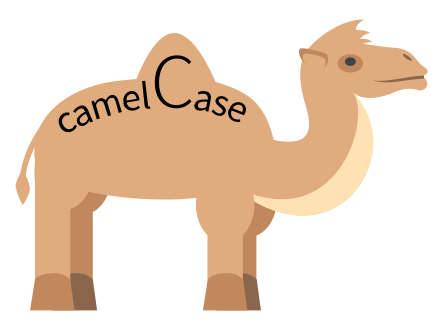最近在学Java咖啡的制作方法,但是我感觉我在成为手冲大师的路上越走越远来着(难绷
此博客持续更新,旨在记录一些重点、易错点、遗忘点以及二次元美图。
命名の法
类 Class - 帕斯卡法 PascalNamingConversion
1
2
3
4
| CargoNum
SpeedOfCar
MyBaby
HighGrade
|
方法 Method - 驼峰法 camelNamingConversion

1
2
3
| positiveGravity
localPeopleAge
bookPage
|
数据类型
基本类型 Primitive Types
该数据类型含 byte short int float boolean char \t 等等 该类型数据按值传递,例如下面代码:
1
2
3
4
5
6
7
8
9
10
11
12
13
14
| package com.eg;
public class Main {
public static void main(String[] args) {
int a = 1;
int b = 2;
a = 5;
System.out.println(b);
}
}
|
该代码先使a = 1,而后令b = a,即 b值与当前a值同为1。 随后变更a为5,但注意基本数据类型按值传递,所以 b仍为a的初始值1。
上面代码运行结果:
1
2
3
| 1
Process finished with exit code 0
|
封装(引用)类型 Reference Types
该类型数据按引用(地址)传递,例:
1
2
3
4
5
6
7
8
9
10
11
12
13
14
15
16
17
|
package com.eg;
import java.awt.*;
public class LearnOne {
public static void main(String[] args) {
Point point1 = new Point(1, 1);
Point point2 = point1;
point1.x = 4;
point1.y = 6;
System.out.println(point2);
}
}
|
1
2
3
4
|
java.awt.Point[x=4,y=6]
Process finished with exit code 0
|
生命流控制流
if-else语句
以下代码展示如何对两个用户输入的数字作比较,并输出结果:
1
2
3
4
5
6
7
8
9
10
11
12
13
14
15
16
17
18
19
20
21
22
23
24
| package com.learn;
import java.util.Scanner;
public class LearnTwo {
public static void main(String[] args) {
Scanner scan = new Scanner(System.in);
System.out.println("First number: ");
int first = Integer.parseInt(scan.nextLine());
System.out.println("Another number: ");
int second = Integer.parseInt(scan.nextLine());
if (first == second) {
System.out.println("The same!");
} else if (first > second) {
System.out.println("Former's larger than latter!");
} else {
System.out.println("Latter's larger than former!");
}
}
}
|
代码逻辑几乎等同于C语言中的同等语句,但是代码语句的缩进大有不同,请看:
C
1
2
3
4
5
6
7
8
9
| if (conditionOne) {
do statementOne;
}
else if (conditionTwo) {
do statementTwo;
}
else {
do statementDefault;
}
|
Java
1
2
3
4
5
6
7
| if (conditionOne) {
do statementOne;
} else if (conditionTwo) {
do statementTwo;
} else {
do statementDefault;
}
|
while语句
While语句超级实用!!!
1
2
3
4
| while (_expression_) {
do statements;
...
}
|
(在while中嵌套if-else时,continue往往可以忽略)
列表
声明和添加项
用ArrayList<*DataType*> *listName* = new ArrayList<>()创建列表,并用*listName*.add()方法向列表中添加项目:
1
2
3
4
5
6
7
8
9
10
11
12
13
14
15
16
17
18
19
20
| import java.util.ArrayList;
public class ArrayDemo {
public static void main(String[] args) {
ArrayList<Integer> list = new ArrayList<>();
list.add(1);
ArrayList<Double> list = new ArrayList<>();
list.add(4.2);
ArrayList<Boolean> list = new ArrayList<>();
list.add(true);
ArrayList<String> list = new ArrayList<>();
list.add("String is a reference-type variable");
}
}
|
数据被存入list后,会被隐式转换为ArrayList<>中声明的类型。
删除项
用*listName*.remove()方法删除特定项。
列表长度
用*listName*.size()方法确定列表长度:
1
2
3
4
5
6
7
8
9
10
|
ArrayList<String> wordList = new ArrayList<>();
wordList.add("First");
wordList.add("Second");
System.out.println(wordList.size());
2
|
判斷項的存在
用*listName*.contains()方法確定列表中是否存在某一特定項目,該方法輸出的是布爾數(true,false):
1
2
3
4
5
6
7
8
9
10
11
12
13
14
15
16
|
ArrayList<String> list = new ArrayList<>();
list.add("First");
list.add("Second");
list.add("Third");
System.out.println("Is the first found? " + list.contains("First"));
if (list.contains("Second")) {
System.out.println("Second can still be found");
}
Is the first found? true
Second can still be found
|
数组
声明
1
| int[] numbers = new int[3];
|
字符串
比较两个字符串
使用equals方法比较两个字符串(不能用==!!):
1
2
3
4
5
6
7
8
9
10
|
String one = "Ello gays";
String two = "Hello owl";
if (one.equals(two)) {
System.out.println("Two string's are same!")
}
Two string's are same!
|
分割字符串
用*name*.split(" *分割界限* ")方法:
1
2
3
4
5
6
7
8
9
10
11
12
13
|
String text = "first_second_third_fourth";
String[] pieces = text.split("_");
for (String block : pieces) {
System.out.println(block);
}
first
second
third
fourth
|
注意分割后的字符要存放在一个数组里!!
判断字符串内包含情况
用*name*.contain(" *包含内容* ")方法判断一个字符串内是否有想要的内容,下面的示例判断了一个字符串内是否含有”av”:
1
2
3
4
5
6
7
| String text = "lava";
if (text.contains("av")) {
System.out.println("av was found");
} else {
System.out.println("av not found");
}
|
定位某个字符
1
2
3
4
5
6
7
|
String text = "Hello world!";
char character = text.charAt(0);
System.out.println(character);
H
|
面向对象编程
备忘
Fun Fact
在IDEA中调用valueOf方法时,IDE给出了下面的建议:

从网上搜寻得知,valueOf内部就用了parseInt,区别在于 parseInt直接返回原始int类型数据;而valueOf又做了封装,返回Integer类型。
还有一个区别,parseInt期待的输入是String,而valueOf不是。
综上所述,一般用parse方法取代valueOf,除非要返回Integer类型,不然还有封装拆箱,性能多少会耗费些。
还有,在编写计算赠与税的程序时,IDE对下面的程序块提出了优化建议:

搜寻之,遂得此:
try-with-resources语句是一个 try 语句,它声明一个或多个资源。资源 是在程序完成后必须关闭的对象。try-with-resources语句确保在语句结束时关闭每个资源。
无论 try 语句是否正常完成或中断,它都将被关闭。
综上,对于内存敏感型的程序来说,在源码内使用try-with-resources语句会更节省寸土寸金的内存(Are u winning, Apple?)。
输出东西
平方
1
| double twoSquareTwo = Math.pow(2, 2)
|
读取输入东西并转为字符串
1
2
| Scanner scanner = new Scanner(System.in)
String input = scanner.nextLine()
|
读取输入的整数/小数/布尔数
一般使用valueOf方法,但是作为高级程序员的初级形态(bushi),我们选择更高级的parse方法:
1
2
3
4
| String stringInput = "</>";
int intVal = Integer.parseInt(stringInput);
double dbVal = Double.parseDouble(stringInput);
boolean booVal = Boolean.parseBoolean(stringInput);
|
(蜜汁)反转判断
用!反转其后的判断条件,比如:
1
2
3
4
5
6
7
8
9
10
11
|
int number = 7;
if (!(number > 4)) {
System.out.println("Number is no greater than 4.");
} else {
System.out.println("Number is greater than 4.")
}
Number is greater than 4.
|
这里的!(number > 4)等同于(number <= 4)。
定位列表/数组元素
切记数组从0存储数据,而size从1开始,所以
index = numbers.size() - 1
判断空数组/列表
1
2
3
4
5
6
7
| if (input.isEmpty()) {
break;
}
if (input.equals("")) {
break;
}
|
异题
“编写一个方法public static String word()。该方法返回一个字符串。”
1
2
3
4
5
6
7
8
9
10
11
12
13
14
15
|
public class StringOutPut {
public static void main(String[] args) {
String output = "op";
word(output);
}
public static void word(String str) {
System.out.println(str);
}
}
op
|
“使程序对用户输入的数字进行搜索,如果数组含该数字,输出该数字以及其位置;否则告知number wasn't found。”
1
2
3
4
5
6
7
8
9
10
11
12
13
14
15
16
17
18
19
20
21
22
23
24
25
26
27
28
29
30
|
public static void main(String[] args) {
Scanner scanner = new Scanner(System.in);
int[] array = new int[10];
array[0] = 6;
array[1] = 2;
array[2] = 8;
array[3] = 1;
array[4] = 3;
array[5] = 0;
array[6] = 9;
array[7] = 7;
System.out.print("Search for? ");
int num = Integer.valueOf(scanner.nextLine());
boolean isFound = false;
for (int i = 0; i < array.length; i++) {
if (num == array[i]) {
System.out.println(num + " is at index " + i);
isFound = true;
}
}
if (!isFound) {
System.out.println(num + " was not found.");
}
}
|
输出所给csv文件中的最长名和平均年龄
1
2
3
4
5
6
7
8
9
10
11
12
13
14
15
16
17
18
19
20
21
22
23
24
25
26
27
| Scanner scanner = new Scanner(System.in);
int yearOfBirth = 0;
int count = 0;
int nameLenght = 0;
String name = null;
while (true) {
String input = scanner.nextLine();
if (input.equals("")) {
break;
}
String[] parts = input.split(",");
if (parts[0].length() > nameLenght) {
nameLenght = parts[0].length();
name = parts[0];
}
yearOfBirth = yearOfBirth + Integer.valueOf(parts[1]);
count = count + 1;
}
System.out.println("Longest name: " + name);
if (count > 0) {
System.out.println("Age average: " + (1.0 * yearOfBirth / count));
} else {
System.out.println("No input.");
}
|




